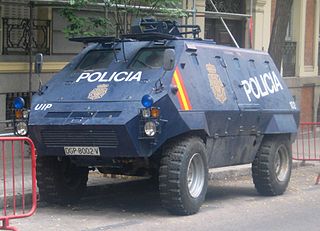
A military armoredcar is a lightweight wheeled armored fighting vehicle, historically employed for reconnaissance, internal security, armed escort, and other subordinate battlefield tasks. With the gradual decline of mounted cavalry, armored cars were developed for carrying out duties formerly assigned to light cavalry. Following the invention of the tank, the armored car remained popular due to its faster speed, comparatively simple maintenance and low production cost. It also found favor with several colonial armies as a cheaper weapon for use in underdeveloped regions. During World War II, most armored cars were engineered for reconnaissance and passive observation, while others were devoted to communications tasks. Some equipped with heavier armament could even substitute for tracked combat vehicles in favorable conditions—such as pursuit or flanking maneuvers during the North African Campaign.

The Panhard AML is an armoured car with reconnaissance capability. Designed on a lightly armoured 4×4 chassis, it weighs an estimated 5.5 tonnes, and is thus suitable for airborne deployment. Since 1959, AMLs have been marketed on up to five continents; several variants remained in continuous production for half a century. These have been operated by fifty-four national governments and other entities worldwide, seeing regular combat.
Textron Marine & Land Systems, formerly Cadillac Gage, is an American military contractor that manufactures armored vehicles, turrets, advanced marine craft, surface effects ships, and other weapon systems. It is owned by Textron, and was formed in the merger between Cadillac Gage and Textron Marine in 1994.

The M8 light armored car is a 6×6 armored car produced by the Ford Motor Company during World War II. It was used from 1943 by United States and British forces in Europe and the Pacific until the end of the war. The vehicle was widely exported and as of 2006 still remained in service with some countries.

The FV601 Saladin is a six-wheeled armoured car developed by Crossley Motors and later manufactured by Alvis. Designed in 1954, it replaced the AEC Armoured Car in service with the British Army from 1958 onward. The vehicle weighed 11 tonnes, offered a top speed of 72 km/h, and had a crew of three. Saladins were noted for their excellent performance in desert conditions, and found favour with a number of Middle Eastern armies accordingly. They were armed with a 76 mm low-pressure rifled gun which fired the same ammunition as that mounted on the FV101 Scorpion.

The Shorland is an armoured patrol car that was designed specifically for the Royal Ulster Constabulary by Frederick Butler. The first design meeting took place in November 1961. The third and final prototype was completed in 1964 and the first RUC Shorlands were delivered in 1966. They were reallocated to the Ulster Defence Regiment in 1970. The Royal Ulster Constabulary soon replaced the Shorland with an armoured Land Rover with more conventional profile and no machine gun turret.

The Cadillac Gage Commando, frequently denoted as the M706 in U.S. military service, is an American armored car designed to be amphibious. It was engineered by Cadillac Gage specifically for the United States Military Police Corps during the Vietnam War as an armed convoy escort vehicle. The Commando was one of the first vehicles to combine the traditionally separate roles of an armored personnel carrier and a conventional armored car, much like the Soviet BTR-40. Its notable height, amphibious capability, and waterproofed engine allowed American crews to fight effectively in the jungles of Vietnam by observing their opponents over thick vegetation and fording the country's deep rivers.

The M1117 Guardian, also denoted Armored Security Vehicle (ASV), is an internal security vehicle based on the V-100 and V-150 Commando series of armored cars. It was developed in the late 1990s for service with the United States' Military Police Corps. The first prototypes appeared in February 1997 and serial production of the M1117 commenced between 1999 and early 2000.
A huge number of M113 Armored Personnel Carrier variants have been created, ranging from infantry carriers to nuclear missile carriers. The M113 armored personnel carrier has become one of the most prolific armored vehicles of the second half of the 20th century, and continues to serve with armies around the world in many roles.

The Cadillac Gage Ranger is a four-wheeled armored personnel carrier produced by Cadillac Gage, built on a Dodge truck chassis. The largest customer was the United States Air Force, which the Ranger was marketed to in order to meet needed requirements as a security/patrol vehicle.

The Dragoon 300 AFV was produced by Arrowpointe Corporation during the 1980s. It was based on the automotive components of the United States Army's M113 APCs and 5-ton trucks. It resembles a larger V-150 Commando.

Bravia was a Portuguese vehicle manufacturer. It started by reconditioning military vehicles and by 1964 it had become a manufacturer in its own right. Its best known product is the wheeled APC Bravia Chaimite.

The Thyssen Henschel UR-416 is a German armoured personnel carrier, first introduced in 1969 and based on the body of the Mercedes-Benz Unimog light truck.

Vinci is a Portuguese-based project for a brand of cars.

Cadillac-Gage manufactures a Cadillac-Gage 1 metre turret for armored vehicles. The turret mounts on a 1-meter turret ring. They were originally armed with a 7.62 mm machine gun, and a 12.7 mm machine gun. By 1984 a version of the turret was introduced where one of the machine guns was replaced by a Mark 19 automatic grenade launcher. The gunner is surrounded by 8 large vision blocks, and has a periscope with a telescopic sight.

The MOWAG Roland is an armoured personnel carrier of Swiss origin. The vehicle was developed in 1960 and the prototype was tested in 1963. The Roland production was from 1964 to 1980.















